brake fluid Hyundai Genesis Coupe 2013 Owner's Guide
[x] Cancel search | Manufacturer: HYUNDAI, Model Year: 2013, Model line: Genesis Coupe, Model: Hyundai Genesis Coupe 2013Pages: 414, PDF Size: 38.89 MB
Page 335 of 414
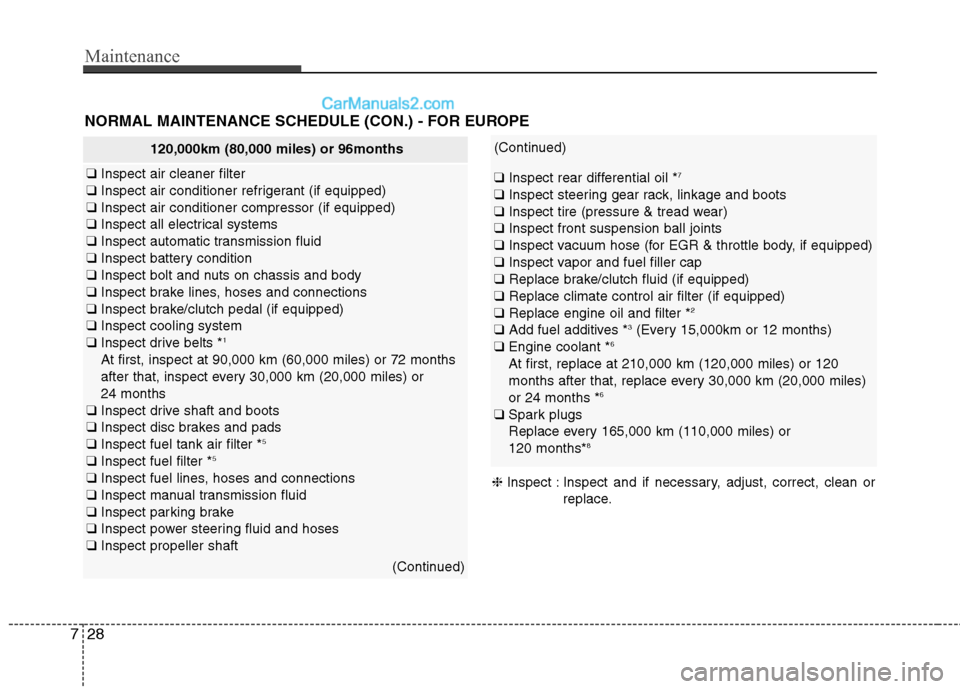
Maintenance
28
7
NORMAL MAINTENANCE SCHEDULE (CON.) - FOR EUROPE
120,000km (80,000 miles) or 96months
❑ Inspect air cleaner filter
❑ Inspect air conditioner refrigerant (if equipped)
❑ Inspect air conditioner compressor (if equipped)
❑ Inspect all electrical systems
❑ Inspect automatic transmission fluid
❑ Inspect battery condition
❑ Inspect bolt and nuts on chassis and body
❑ Inspect brake lines, hoses and connections
❑ Inspect brake/clutch pedal (if equipped)
❑ Inspect cooling system
❑ Inspect drive belts * 1
At first, inspect at 90,000 km (60,000 miles) or 72 months
after that, inspect every 30,000 km (20,000 miles) or 24 months
❑ Inspect drive shaft and boots
❑ Inspect disc brakes and pads
❑ Inspect fuel tank air filter * 5
❑ Inspect fuel filter * 5
❑ Inspect fuel lines, hoses and connections
❑ Inspect manual transmission fluid
❑ Inspect parking brake
❑ Inspect power steering fluid and hoses
❑ Inspect propeller shaft
(Continued)
(Continued)
❑Inspect rear differential oil * 7
❑ Inspect steering gear rack, linkage and boots
❑ Inspect tire (pressure & tread wear)
❑ Inspect front suspension ball joints
❑ Inspect vacuum hose (for EGR & throttle body, if equipped)
❑ Inspect vapor and fuel filler cap
❑ Replace brake/clutch fluid (if equipped)
❑ Replace climate control air filter (if equipped)
❑ Replace engine oil and filter * 2
❑ Add fuel additives * 3
(Every 15,000km or 12 months)
❑ Engine coolant * 6
At first, replace at 210,000 km (120,000 miles) or 120
months after that, replace every 30,000 km (20,000 miles)or 24 months * 6
❑ Spark plugs
Replace every 165,000 km (110,000 miles) or 120 months* 8
❈ Inspect : Inspect and if necessary, adjust, correct, clean or
replace.
Page 340 of 414
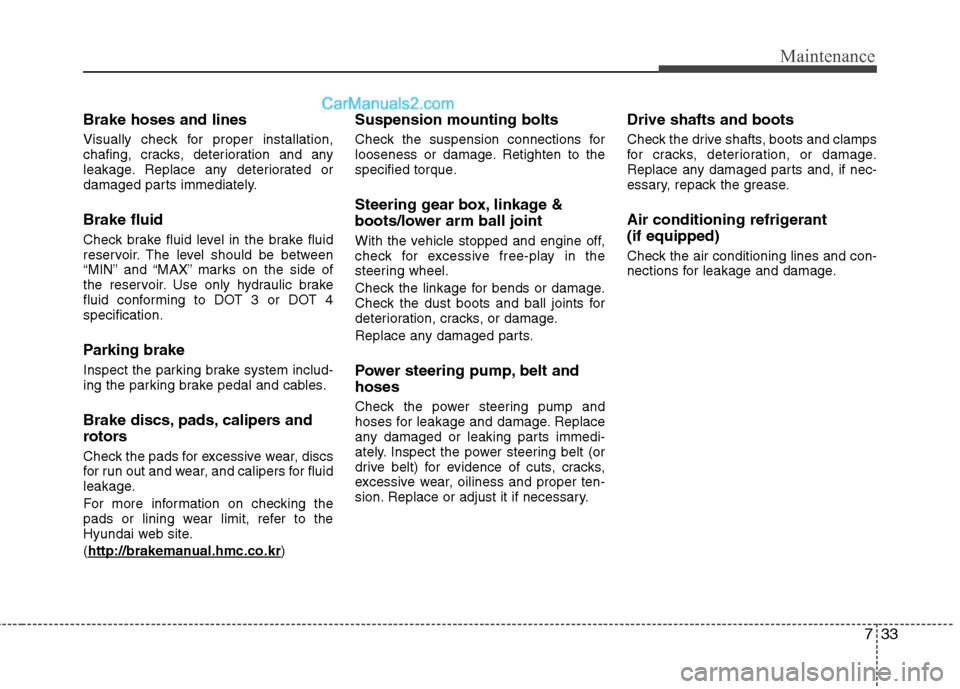
733
Maintenance
Brake hoses and lines
Visually check for proper installation,
chafing, cracks, deterioration and any
leakage. Replace any deteriorated or
damaged parts immediately. Brake fluid
Check brake fluid level in the brake fluid
reservoir. The level should be between
“MIN” and “MAX” marks on the side of
the reservoir. Use only hydraulic brake
fluid conforming to DOT 3 or DOT 4specification.
Parking brake
Inspect the parking brake system includ-
ing the parking brake pedal and cables.
Brake discs, pads, calipers and
rotors
Check the pads for excessive wear, discs
for run out and wear, and calipers for fluid
leakage.
For more information on checking the
pads or lining wear limit, refer to the
Hyundai web site. (http://brakeman
ual.hmc.co.kr) Suspension mounting bolts
Check the suspension connections for
looseness or damage. Retighten to the
specified torque.
Steering gear box, linkage &
boots/lower arm ball joint
With the vehicle stopped and engine off,
check for excessive free-play in the
steering wheel.
Check the linkage for bends or damage.
Check the dust boots and ball joints for
deterioration, cracks, or damage.
Replace any damaged parts.
Power steering pump, belt and hoses
Check the power steering pump and
hoses for leakage and damage. Replace
any damaged or leaking parts immedi-
ately. Inspect the power steering belt (or
drive belt) for evidence of cuts, cracks,
excessive wear, oiliness and proper ten-
sion. Replace or adjust it if necessary.
Drive shafts and boots
Check the drive shafts, boots and clamps
for cracks, deterioration, or damage.
Replace any damaged parts and, if nec-
essary, repack the grease.
Air conditioning refrigerant (if equipped)
Check the air conditioning lines and con-
nections for leakage and damage.
Page 346 of 414
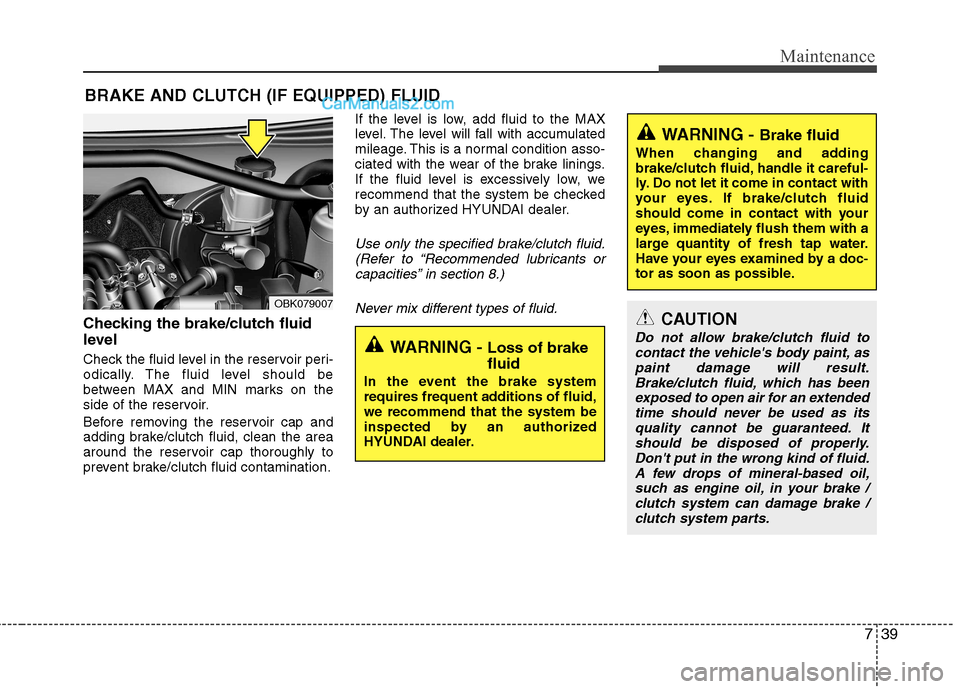
739
Maintenance
BRAKE AND CLUTCH (IF EQUIPPED) FLUID
Checking the brake/clutch fluid
level
Check the fluid level in the reservoir peri-
odically. The fluid level should be
between MAX and MIN marks on the
side of the reservoir.
Before removing the reservoir cap and
adding brake/clutch fluid, clean the area
around the reservoir cap thoroughly to
prevent brake/clutch fluid contamination. If the level is low, add fluid to the MAX
level. The level will fall with accumulated
mileage. This is a normal condition asso-
ciated with the wear of the brake linings.
If the fluid level is excessively low, we
recommend that the system be checked
by an authorized HYUNDAI dealer.
Use only the specified brake/clutch fluid.
(Refer to “Recommended lubricants orcapacities” in section 8.)
Never mix different types of fluid.
WARNING - Brake fluid
When changing and adding
brake/clutch fluid, handle it careful-
ly. Do not let it come in contact with
your eyes. If brake/clutch fluid
should come in contact with your
eyes, immediately flush them with a
large quantity of fresh tap water.
Have your eyes examined by a doc-
tor as soon as possible.
WARNING - Loss of brake fluid
In the event the brake system
requires frequent additions of fluid,we recommend that the system be
inspected by an authorized
HYUNDAI dealer.
OBK079007
CAUTION
Do not allow brake/clutch fluid to contact the vehicle's body paint, aspaint damage will result.
Brake/clutch fluid, which has beenexposed to open air for an extended time should never be used as itsquality cannot be guaranteed. It
should be disposed of properly.Don't put in the wrong kind of fluid. A few drops of mineral-based oil,such as engine oil, in your brake /
clutch system can damage brake /clutch system parts.
Page 349 of 414
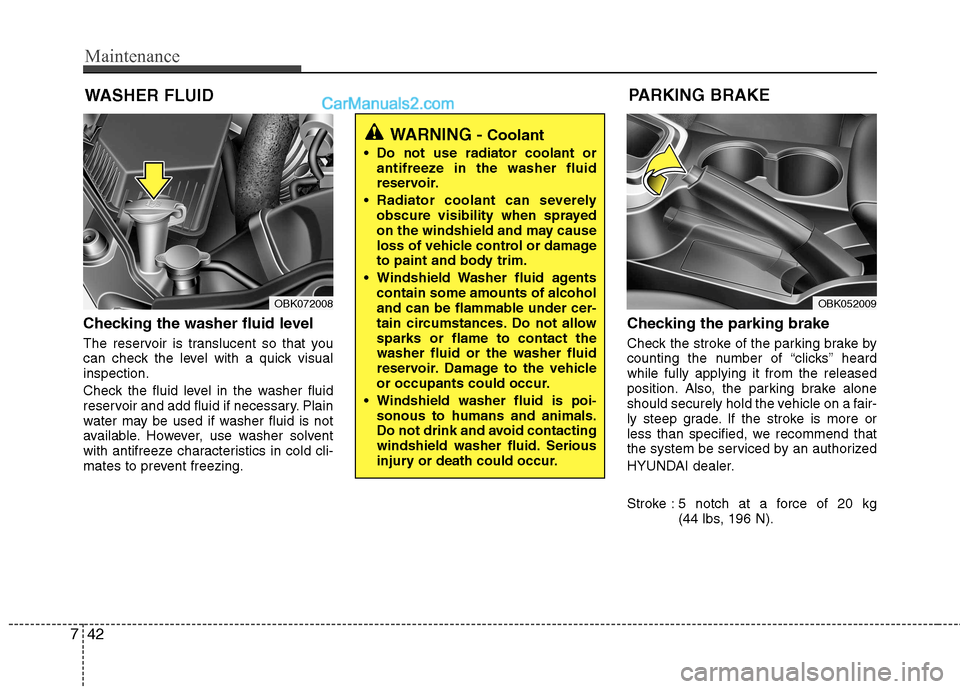
Maintenance
42
7
WASHER FLUID
Checking the washer fluid level
The reservoir is translucent so that you
can check the level with a quick visualinspection.
Check the fluid level in the washer fluid
reservoir and add fluid if necessary. Plain
water may be used if washer fluid is not
available. However, use washer solvent
with antifreeze characteristics in cold cli-
mates to prevent freezing. Checking the parking brake
Check the stroke of the parking brake by
counting the number of “clicks’’ heardwhile fully applying it from the released
position. Also, the parking brake alone
should securely hold the vehicle on a fair-
ly steep grade. If the stroke is more or
less than specified, we recommend that
the system be serviced by an authorized
HYUNDAI dealer.
Stroke : 5 notch at a force of 20 kg
(44 lbs, 196 N).
WARNING - Coolant
Do not use radiator coolant or antifreeze in the washer fluid
reservoir.
Radiator coolant can severely obscure visibility when sprayed
on the windshield and may cause
loss of vehicle control or damage
to paint and body trim.
Windshield Washer fluid agents contain some amounts of alcohol
and can be flammable under cer-
tain circumstances. Do not allowsparks or flame to contact thewasher fluid or the washer fluid
reservoir. Damage to the vehicle
or occupants could occur.
Windshield washer fluid is poi- sonous to humans and animals.
Do not drink and avoid contacting
windshield washer fluid. Serious
injury or death could occur.
OBK052009
PARKING BRAKEOBK072008
Page 410 of 414
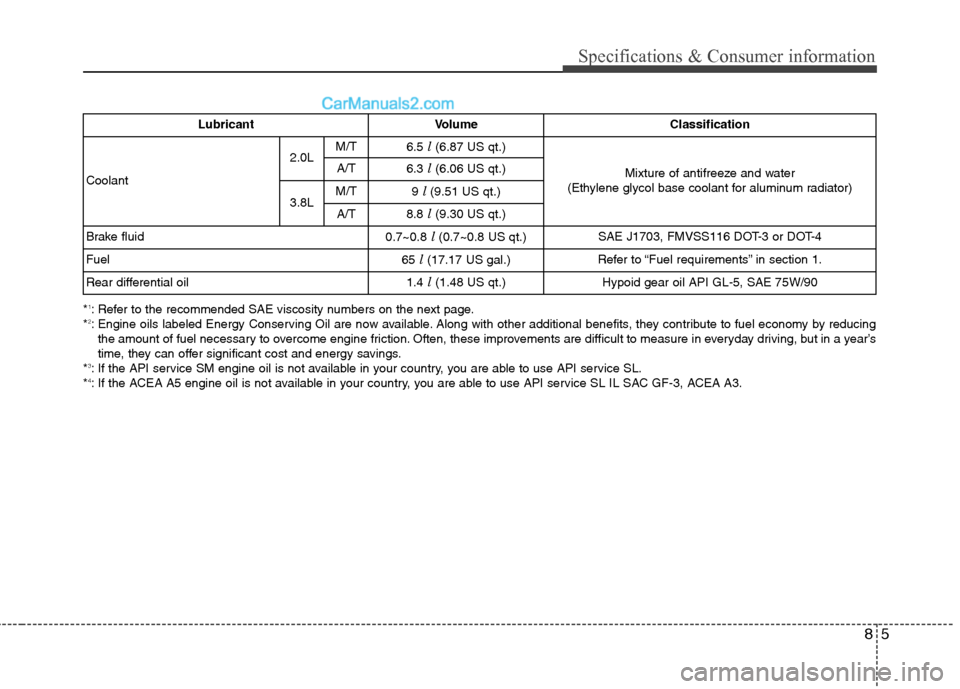
85
Specifications & Consumer information
*1
: Refer to the recommended SAE viscosity numbers on the next page.
* 2
: Engine oils labeled Energy Conserving Oil are now available. Along with other additional benefits, they contribute to fuel economy by reducing
the amount of fuel necessary to overcome engine friction. Often, these improvements are difficult to measure in everyday driving, but in a year’s
time, they can offer significant cost and energy savings.
* 3
: If the API service SM engine oil is not available in your country, you are able to use API service SL.
* 4
: If the ACEA A5 engine oil is not available in your country, you are able to use API service SL IL SAC GF-3, ACEA A3. Lubricant Volume Classification
Coolant
2.0L M/T
6.5l (6.87 US qt.)
Mixture of antifreeze and water
(Ethylene glycol base coolant for aluminum radiator)A/T6.3 l (6.06 US qt.)
3.8LM/T9 l (9.51 US qt.)
A/T 8.8l (9.30 US qt.)
Brake fluid 0.7~0.8l (0.7~0.8 US qt.) SAE J1703, FMVSS116 DOT-3 or DOT-4
Fuel 65l (17.17 US gal.) Refer to “Fuel requirements” in section 1.
Rear differential oil 1.4l (1.48 US qt.) Hypoid gear oil API GL-5, SAE 75W/90